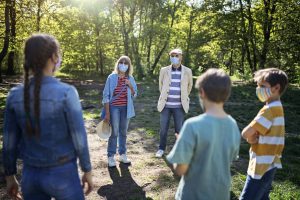 In this fourth post of my coronavirus terms series, I’ll examine some terms that are being discussed more often as we enter a critical new phase of the pandemic response.
In this fourth post of my coronavirus terms series, I’ll examine some terms that are being discussed more often as we enter a critical new phase of the pandemic response.
The second wave
Coronavirus is called a once-in-a-century pandemic because the last one was just over a century ago. The 1918 flu pandemic, which lasted from February 1918 through April 1920, infected 500 million people (at that time approximately one third of the world’s population). Its estimated death toll was between 17 million and 50 million people. Of its four successive waves, its second wave during the autumn and winter of 1918 was the deadliest.
Based on this, public health experts have been warning that the gravest danger from coronavirus will come from the second wave starting in late autumn and continuing through winter. They've warned about this ever since the start of the coronavirus in the spring (in the northern hemisphere). Consider these relevant facts from the 1918 pandemic:
- The summer of 1918 flattened the curve (i.e., slowed and reduced infection rates), apparently aided by the heat and humidity of the season.
- It’s easier to engage in socially distant activities outdoors. In 1918, people were lulled into a false sense of security over the summer – then the real pandemic exploded in winter.
Many forecasted a similar trajectory for the coronavirus. Unfortunately, especially in the United States, the summer did not flatten the curve. In fact, we never really brought community spread down to a manageable baseline in most of the country. We also suffered through periodic large outbreaks, even in the hottest and most humid parts of the country. And now, winter is coming. People are heading indoors, making social distancing harder and community spread easier.
Since the summer didn’t give us the virus vacation we hoped for, pandemic fatigue is rising. Autumn may see as many masks falling from faces as leaves from trees. People will get sick because they are tired of trying to avoid getting sick.
Herd immunity and vaccines
Another term we hear a lot these days is herd immunity. The basic concept is when a significant percentage (approximately 75% according to many experts) of a population develops immunity to an infection, the likelihood that the rest of population will get infected is greatly reduced – regardless of their individual immunity. The bottom line is immune individuals are unlikely to contribute to community spread, thereby disrupting chains of transmission and slowing the spread of disease.
Natural herd immunity, which has been attempted in Sweden and has been discussed by other governments and leaders, means allowing a disease to spread unabated throughout a population until enough people get infected. The problem is that even with a 1% infection fatality risk, millions of people would die along the way to achieving natural herd immunity.
Sterilizing versus functional immunity
Even though natural herd immunity is not the answer, herd immunity is still the underlying strategy of vaccination. The best vaccine would provide a population with a sufficient amount of sterilizing immunity. This means the vaccine would block coronavirus transmission. However, most vaccine frontrunners for approval may only provide functional immunity, which means the vaccine would protect against severe coronavirus symptoms.
While there are many reasons to be optimistic about the availability of vaccines next year, when they arrive they may deliver more chaos than cure. For one thing, most vaccines are not cures. The flu vaccine, for example, doesn’t eradicate the flu. Instead, it reduces the flu’s negative impact on public health. But the biggest looming coronavirus vaccine chaos has to do with the difficulties involved in distribution and deployment.
Logistical challenges
The first logistical challenge with leading vaccine candidates is they are inherently sensitive to heat. As such, they require extreme cold storage (-94 degrees Fahrenheit) for transportation, which limits how and where they can be shipped. Once arriving at their destination and thawed to normal fridge temperatures, they must be used within one to two weeks.
Another logistical challenge is that the leading candidates are two-dose vaccines. This means you get one dose, wait several weeks (longer than the vaccine can be stored in a fridge), then get a second dose of the same vaccine from the same manufacturer. The last point is complicated by the fact that there are currently dozens of vaccines in clinical trials in the United States alone. So the market will soon be inundated with multiple approved vaccines with varying levels of effectiveness. It will take a considerable amount of time to determine which approved and administered vaccines are the most effective.
Having the right number of the right vaccines for the right number of people will require complex supply chain management, extensive record keeping and vigilance on the part of both healthcare providers and patients. And, of course, there is the added challenge of convincing enough of the population to get completely vaccinated to achieve the right kind of herd immunity.
Three therapies
Thankfully, vaccines are neither our only hope nor our only option. The truth is it will require more than a vaccine to defeat COVID-19. Three kinds of therapies are currently being developed and may soon be widely available. Alone or, more likely, when used in combination with a vaccine, these three therapies could help us turn the tide.
- Antivirals — While a vaccine prepares your immune system to prevent an infection, antivirals are drugs that fight back against an existing infection. In other words, vaccines are defense, antivirals are offense. Antivirals attack and sabotage coronavirus replication within your body that drives symptoms, and are most effective during the early stages of the disease or against a mild case. Remdesivir is the only antiviral shown to work against coronavirus so far, and it can only be given intravenously in a hospital. More antivirals are being developed, including oral drugs that can be prescribed and taken at home.
- Antibodies — Also a post-infection therapy, but antibodies are created by our own cells within our blood. This therapy transfers them from one person’s body to another. Convalescent plasma from recovered coronavirus patients is the only antibody therapy for coronavirus so far. Antibody drugs (or monoclonal antibodies) are currently in clinical trials. Pharmaceutical companies are synthetically growing these in vats of cells. Antibodies could never be packaged into a pill since they’re easily digested by stomach acid. So this therapeutic option has to be administered intravenously or as an injection.
- Immunomodulators — Antivirals and antibodies, either alone or more likely in combination, can treat mild cases of coronavirus or help combat the early phase of more severe cases when coronavirus replication is the danger. The second phase of severe cases is when our own immune response overreacts and damages our body, sometimes fatally. This is where immunomodulators can help. These drugs suppress the overactive immune response. The generic steroid dexamethasone is the only immunomodulator shown to work against coronavirus so far. It may be partly responsible for declining death rates by reducing the chances intubated patients die. But the search is on for more and better immunomodulators.
The end is not near
The pandemic has reminded us that dashboards and metrics enable data-informed decisions and data-driven actions. The proper interpretation of COVID-19 data – especially under the guidance of experts in infectious disease and public health – helps us understand concepts like the symptomatic spectrum and the contagious continuum.
Although we know what we need to do, our commitment is challenged by how long coronavirus lingers. The truth is the end is not near. We are not doomed – but we have a long way to go before we overcome coronavirus. As much as we want a vaccine or a therapy to save us, continuing social distancing and wearing masks will make us the superheroes we need to keep believing in. We also need to continue widespread testing and contact tracing while quarantining the exposed and isolating the infected.
Help is on the way. Let’s all stay the course until it arrives. We can do this. Stay safe and be well.
View the COVID-19 dashboard from SAS






